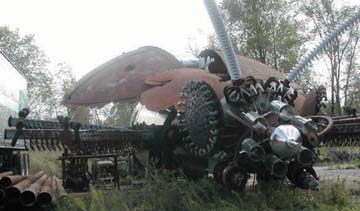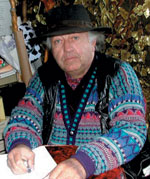





Welding Art and History:
Dr. Evermor transforms
industrial wreckage into multi-ton sculptures
by Angela Salvo
 |
A giant bee is part of the
scenery at the Evermor Foundation Historic Artistic Sculpture Park.
Dr. Evermor’s creations are made by welding industrial scrap material. Photo by Angela Salvo |
We walked through a maze
of welded, waist-high creatures. Autumn leaves carpeted our path and tangled
between the statues. He offered me a cigar.
“No thanks,” I declined. “I don't smoke.”
“Yeah, neither do I.” He spit the cigar tip out and flashed me
a wink. Step after step, I followed as we made our way to the door of what
might have once been a semi-trailer. He threw the metal door open; the wind
threw it back. He led me into the structure, a narrow passage bordered on
both sides with heaps of clutter stacked on shelves and shelves of clutter
stacked on heaps. Road signs, puppets and various contraptions threw shadows
that pointed to another door at the end of the walkway. He reached up to unlatch
the door and pulled himself into the room. Gold light spilled out through
the doorway. Curiosity pushed me forward. I stepped into his office. Gold-plated
vines ran up the walls and across the ceiling. He sat behind his homemade
red-vinyl desk, finally able to light his stogie.
This is Tom Every, 64, husband to Eleanor, father to Troy, retired scrap-metal dealer and artist. He has spent almost the last two decades building an outdoor art park of towering metal sculptures. This is Dr. Evermor, dreamer and inventor of the Forevertron, an electromagnetic-driven vehicle en route to the heavens. Although the two identities merged only 20 years ago, this story began more than a century before.
The legend of
Dr. Evermor
The
year is 1890, and the place is Eggington, England. The legend of Dr. Evermor
begins with lightning. When asked, Dr. Evermor’s father, a Presbyterian
minister, attributes the power and sublimity of electricity and magnetism
directly to God. Moved by the notion of such power, and wanting to escape
the uncertainties and societal hypocrisy of his world, Evermor dedicates his
life to leashing the energy source (lightning) directly by building a vessel
that could propel him into the heavens themselves. He plans for the main vehicle,
a glass ball inside a copper egg, to ride a magnetic lightning beam into the
unknown. The legend ends there. Was this character fictional, or was he simply
created to inspire an artist?
Tom Every—a modern Dr. Evermor
 |
| Dr. Evermor used his knowledge from his early
businesses to create his sculptures. Photo by Angela Salvo |
The year is 1938. Tom
Every is born in Madison, three years before the U.S. enters World War II.
This time frame proved crucial, as it set Every’s fate before him. Every
and his family began collecting and recycling newspapers, rags and scrap for
the war effort. He continued collecting after the war, with his Cub Scout
troop in Brooklyn, Wis., and, when the scouts stopped, as a private collector
and distributor of used materials mostly to a scrap yard in Janesville. By
age 11, Every founded the Brooklyn Salvage Company. At age 20, he formed the
Wisconsin By-Products Corporation in Stoughton and recycled by-products for
U.S. Rubber until 1964. For 20 years after that, Every supervised the wrecking
of more than 350 industrial sites across the country. His career developed,
but his hobby and interests surface as the forerunner of motive.
“I didn’t know if I was after anything,” said Every in an
interview published in Bottlecap magazine. “I did go through this bout
of inhuman treatment that our society insists on putting us through, and maybe
that was the start of it. Since then, I’ve gained a different thought
pattern and look at it a little more humorously.”
Every started to notice
the distinctions. He began to step back and look at his work with a new perspective.
Beauty could be found anywhere. For Every, it surfaced in the scrap he destroyed
for a living.
Tom Every’s transition to Dr. Evermor coincided with his transition
from wrecking and recycling to art and promotion of the 19th and early 20th
century industrial designs. He wanted to honor the shapes he had once melted
down to shapeless, so he stopped destroying and started creating. The House
on the Rock in Spring Green and the Don Q Inn in Dodgeville still house his
earlier pieces—metal fantasy machines.
Dr. Evermor’s
dream come true
In
1984, Every undertook a greater venture. Already retired from the industrial
wrecking industry, he used his odd collection of scrap metal to begin building
the Forevertron and the outlying sculpture park in North Freedom. At this
time, he became Dr. Evermor.
“Since then, I’ve been happy putting one little piece next to another and building these things,” Evermor said in Bottlecap. “Still, the entire project up here is fundamentally centered around the Forevertron and perpetuating oneself back into the heavens, wherever that might be.”
The park contains hundreds of Evermor’s creations, ranging from pieces that could fit in your hand to the main Forevertron piece, which recent sources estimate to weigh 400 tons and measure 50 feet high, 60 feet deep and 120 feet long. Through each of these pieces, which may contain thousands of smaller bronze, copper, iron, steel or brass parts dating from 1850 to 1930, Evermor lives out his philosophy of combining objects rather than altering their basic form.
“Rather than imposing one’s will on something that has already been created, you leave it alone,” says Evermor. “You just got to take whatever it is and go with it. I don’t impose my will on any parts, and that way everything keeps its original energy.”
Dr. Evermor’s persona, and his mission to launch the Forevertron, can be seen in every piece in the park. The actual space capsule, a copper-ribbed glass egg, sits atop an impressive series of generators, thrusters and various sources of electromagnetic power. Arched bridges, cone-topped towers, rotating instruments and various machines interplay in the main Forevertron piece. The south end exhibits a wrought-iron gazebo (that serves as an observation deck for takeoffs) situated two stories up a spiral staircase. At the north end, mounted on another multistory platform, is the Great Celestial Telescope, where one can monitor the flight into the heavens.
Separate from the main structure are various structures to aid Evermor in his flight. The Celestial Listening Ear allows one to hear Evermor’s final words as he drifts through space. The Graviton sheds some of Evermor’s weight before takeoff to allow for a smoother ride. The Overlord Master Control monitors and controls the flight of the capsule. The Love Guns, two gigantic barrels, aim at the sky and whatever or whoever might get in the way. The Juicer Bug stores a backup of electromagnetic energy.
Even more structural contraptions offer comfort and concession to the mass of spectators. The Epicurean, a lunch counter, serves food to the onlookers. The Olfactory serves as a giant popcorn stand. Several open-air gazebos allow the crowd to watch in ease. Evermor even constructed a multi-member bird band to commence his departure with a song.
“And it’s the only bird band in the world,” Evermor claims.
Still in the process of completing his Forevertron park, Evermor’s latest project includes five 5-ton dragons that will helm his bird band. Musical chiming and Tibetan bells will drape each of the dragons’ designs to allow for a harmonic sculpture with the wind playing as the musician.
“They will not be of this world,” Evermor says. “In the Western culture, the dragon is seen as fearful. And in Eastern philosophy the dragon is seen as more festive, not fearful. My design will be neither. Whatever shape they take on, these serpentine creatures will be intergalactic, a form that has never been seen before.”
As for the future of the Forevertron beyond Evermor’s lifespan, fears of his masterpiece being dismantled and sold for the value of its individual parts no longer concern the doctor. In 1999, the nonprofit Evermor Foundation was established to ensure the park’s maintenance. Evermor sells roughly 800 of his sculptures yearly, ranging in price from $50 to thousands of dollars. Revenue generated by sculpture sales—either purchased online or directly from the park—goes to the support and promotion of the park and the foundation.
“I want my park to reflect what a person can do with nothing,” says Evermor. “Because the biggest challenge was not resource. All these parts were there for the taking; society threw them out. The real challenge is generating a space of complete open happiness, love and compassion.”
The Evermor Foundation Historic Artistic Sculpture Park, located on Hwy. 12 just south of Baraboo, is free and open to the public year-round, Monday through Saturday 9 a.m. to 5 p.m. and Sunday noon to 5 p.m.
Home | Cruising | Refueling | 20 Pt. Inspection